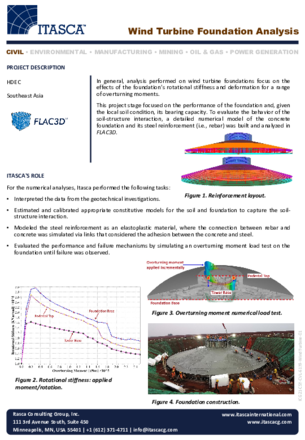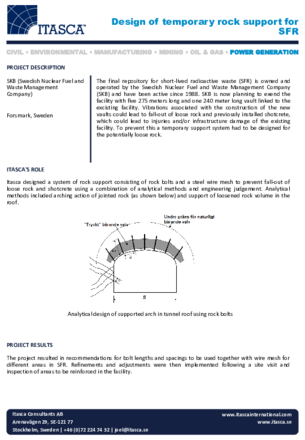
Wind Turbine Foundation Analysis (2021)
In general, analysis performed on wind turbine foundations focus on the effects of the foundation’s rotational stiffness and deformation for a range of overturning moments. This project stage focused on the performance of the foundation and, given the local soil condition, its bearing capacity. To evaluate the behavior of the soil-structure interaction, a detailed numerical model of the concrete foundation and its steel reinforcement (i.e., rebar) was built and analyzed in FLAC3D.

Design of temporary rock support for SFR (2021)
LKAB’s Kiirunavaara Mine is a large, underground, sub-level caving mine that has been seismically active since approximately 2008. With this seismic activity comes associated vibrations. These vibrations can be felt on surface in the town of Kiruna, which is currently located close to the mine on the hangingwall side. The mine is undergoing a national permitting process concerning a desired increased production rate. An important question for this process is: will the increased production rate result in changes to vibrations in the town due to seismicity?

Caving Propagation Study for the Esmeralda Block 1 (2020)
With the transition from Open Pit to Block Cave mining at the Chuquicamata Underground Project, it was necessary to validate ITASCA´s caving algorithm (IMASS) as used to predict caveability in a structurally controlled environment. CODELCO proposed a case study at Esmeralda Mine, El Teniente Division, which was known to have been influenced by the presence of a few major faults in its development.

Numerical calculations for the pre-dimensioning of the support lining in a ventilation shaft (2020)
A ventilation shaft in Germany is part of a former colliery and was put into operation in the late 19th century with a depth of approx. 600 m. Since the colliery was closed down, it has been part of the central water drainage system at the site, together with further shafts in the near distance. In the course of technical reconstruction measures, the shaft is to be converted from a ventilation shaft to a well shaft. For this purpose, the current diameter has to be expanded to a clearance of 3.3 m. The shaft, which was previously constructed with approx. 50 cm thick brick masonry, will be secured with a concrete shell after expansion. To evaluate the predimensioning of the shell, a numerical modeling of the secondary stress field is necessary.

Modeling of Spalling in PFC3D — A Quantitative Assessment (2020)
SKB is interested in developing a 3D discrete model to predict spalling on the excavation boundaries of underground repositories for the long-term storage of spent nuclear fuel. This project provided a quantitative assessment of modeling spalling using PFC3D to study both lab- and tunnel-scale behavior.

Simulating Spalling With a Flat-Jointed Material (2020)
Long-term storage of spent fuel is critical to the nuclear energy industry. The Swedish Nuclear Fuel and Waste Management Company (SKB) is developing an approach for the storage of spent nuclear fuel in an underground repository in competent crystalline rock. In order to better understand the spalling damage process, an in-situ test involving the drilling of two boreholes was performed in Äspö diorite at SKB’s underground hard rock laboratory in Äspö. Tests and monitoring were performed on the pillar that separated the boreholes. In order to further investigate the damage process, Itasca performed numerical modeling using PFC3D and FLAC3D.

Effect of Shear Stresses on Pillar Stability Performance at Troy Mine (2019)
At Troy Mine, a progression of pillar failures led to surface subsidence. Itasca back-analyzed this behavior, using a large-scale numerical model, to understand the level of stresses and failure mechanism leading to the collapse of some pillars. Forward predictions on pillar stability in another nearby deposit, in a similar geomechanical setting, were also done.

Pore Pressure Model for Large Open Pit Mine in the North of Chile (2019)
For over five years, Itasca Chile SpA (Itasca) has developed and continuously updated, the 3D numerical groundwater flow model for this open pit mine in Chile. The model is primarily used to estimate pore pressure distributions for past, present, and predictive stages of the pit excavation. These are subsequently used for 3D slope stability analysis. With the new and updated model, new predictions for future stages were made, and new mining and drainage plans were evaluated from a hydrogeological point of view.

Numerical simulations of shield support for a coal mine (2019)
The development and mining of a deeper seam in a coal mine, located in southern Siberia is planned. ITASCA was tasked with assessing the minimum support pressure and maximum unsupported distance between shield and coal face required to ensure stability of the roof. Also the stress state, displacement field and excavation damaged zone in the roof of the seam were analyzed.

Seismic Performance of the OPC Puerto Cortes Container Terminal in Honduras (2019)
Itasca conducted a seismic performance evaluation of the trestle‐wharf section of the OPC Puerto Cortes Container Terminal, located in Honduras. A FLAC3D analysis of the soil is performed, including the piles and deck of the terminal. This is a fullycoupled, dynamic, soil‐structure, time‐history analysis that quantifies the performance and potential risks for the structure and slope. The Finn model – Byrne formulation was utilized using data from investigation boreholes.

Penetration of a Single Steel Foundation Pin in a Granitic Rock (2018)
The development of a subsea tidal turbine requires specific research work concerning the design of the foundation in contact with the seabed. This design stage can be simplified by the use of numerical modelling and more particularly by using discrete modelling. HydroQuest asked Cathie Associates to check their previous calculations regarding the behavior of a single steel foundation pin in a granitic rock mass by using Itasca’s discrete numerical approach and follow the forces applied to the pin as well as the state of the damaged zone around the tip during penetration.

Modeling Blast-induced Vibrations to Limit Damage to Underground Stopes (2018)
With concurrent open-pit mining and sub-level open stoping under way at Rampura Agucha, the goal of this work was to gain insight into how blasts should be designed to better protect underground excavations. FLAC3D models were used to link the small-scale detonation and crushing behavior to the mine-scale stress wave propagation behavior.

Development of Conceptual and Numerical Groundwater Models for EIA Studies (2018)
Itasca Chile SpA was retained to develop a numerical 3D groundwater flow model that would allow the assessment of potential environmental impacts over the aquifer due to the infiltration associated with the expansion of the Tailings Storage Facility (TSF). Additionally, it was requested to study the potential influence of infiltrations on the mine pit located about 3 km of the TSF.

Modelling over-boring and extension of a tunnel with surrounding excavations (2018)
As part of phase four in the extension of the ANDRA Meuse/Haute-Marne Underground Research Laboratory, a safety niche (called GT1) will be over-bored into a larger section, then extended. The tunnel axis is 16 m from an auxiliary shaft (named PX). Two perpendicular drifts, called GLN and GLE, connect these 2 excavations.

Junction Dam (2018)
Built between 1959 and 1961, Junction Dam is a double-curvature concrete arch dam located on Silver Creek in El Dorado County, California, just downstream from where Little Silver Creek and South Fork Silver Creek merge. The dam is in a relatively narrow canyon with steep sides and retains the Junction Reservoir.
